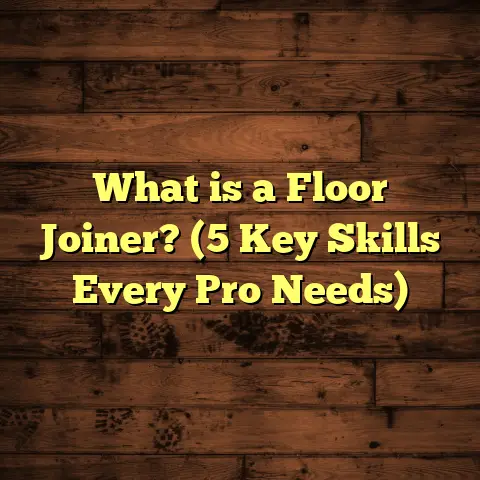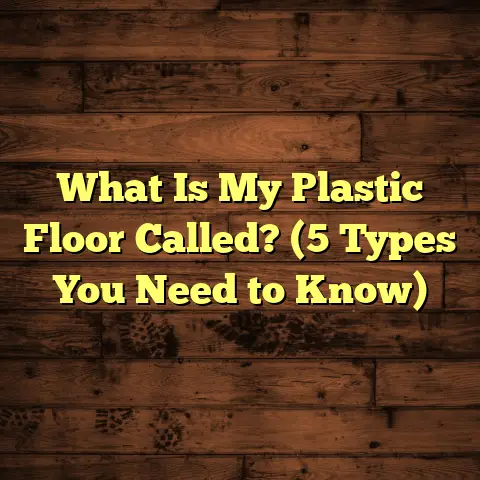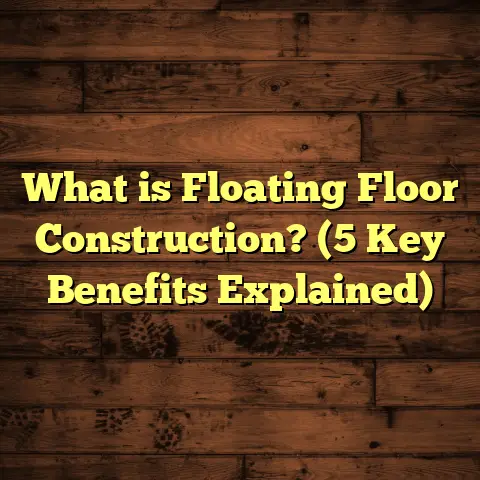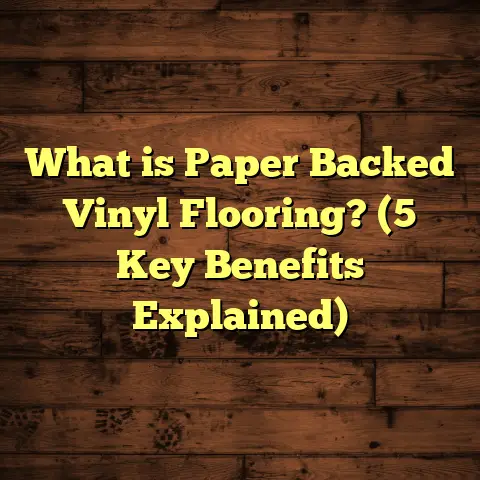What Is Under My Floor? (5 Secrets Your Floors Hide)
What Is Under My Floor?
I still remember the day I first pried up a floorboard in an old house I was hired to renovate. It was a quiet moment, filled with curiosity and a little anticipation. What would I find beneath? Was it just plain old wood and nails, or something more? To my surprise, there was a stack of newspapers dated back to the 1920s and some forgotten bits of life from decades ago. That simple act of lifting a floorboard opened my eyes to how much our floors hide — secrets about the past, clues about the present condition, and warnings about what might come next.
That experience stuck with me throughout my career as a flooring contractor. Over the years, I’ve seen everything from hidden water damage that could have ruined a whole house, to layers of flooring that told stories of changing design trends through generations. Today, I want to share those insights with you, starting from the basics and moving into some of the more surprising truths hidden underneath your floors.
What Is Under Your Floor?
Before we get into the secrets floors hide, let’s start with the basics. When you walk across your floor, you’re standing on several layers stacked together like a sandwich. Each layer has its own job to do. Understanding these layers helps you know what might be going wrong if you have problems or what to expect when you plan a renovation.
The Visible Floor Covering
This is the part you see every day—the hardwood boards, carpet, tile, laminate, or vinyl. This top layer is what gives your room its look and feel. But it’s only the surface of a more complex system.
The Underlayment
Beneath the finish floor is often an underlayment. Think of this as a cushion or buffer. For example, carpet has padding underneath for comfort. Laminate floors usually have foam underlayments that reduce noise and protect against moisture. Tile floors often have cement backer boards which create a solid base.
The Subfloor
This is the first major structural layer beneath the finish floor and underlayment. Usually made from plywood or OSB (oriented strand board), the subfloor provides strength and stability. It attaches directly to the floor joists below it.
Floor Joists
These are the heavy wooden beams that span across your foundation or basement walls. They carry all the weight of your floor system down to the foundation. Joists are usually spaced 12 to 16 inches apart but can vary based on local building codes and house age.
The Foundation or Crawl Space
Below the joists lies either the foundation slab or an open crawl space. Crawl spaces are areas beneath houses raised off the ground, sometimes used for plumbing or electrical access. Foundations support everything above and often include concrete slabs or footings directly on the ground.
Secret #1: Hidden Moisture and Its Impact
Imagine this: your beautiful hardwood floor starts to buckle or warp for no obvious reason. You check for spills but find nothing on the surface. What could be wrong? The answer might be hiding beneath—in moisture trapped under your floor.
How Moisture Gets Under Floors
Moisture under floors can come from several sources:
- Ground moisture: In homes with concrete slabs, moisture can rise up through tiny pores in the concrete if there’s no adequate vapor barrier.
- Leaking pipes: Plumbing leaks beneath floors can go unnoticed for months before causing visible damage.
- Humidity: In crawl spaces without proper ventilation, high humidity levels trap moisture in the air.
- Flooding: Water intrusion during storms or from poor drainage can saturate subfloors and joists.
I recall working on a house where an unnoticed leak under the kitchen caused hardwood boards to swell after just a few months. The homeowner thought it was a finish problem until we lifted the floor and found soggy subflooring beneath.
The Consequences of Moisture
Moisture leads to wood rot, mold growth, and structural weakening. Mold doesn’t just smell bad—it can cause health issues for occupants, especially those with allergies or respiratory problems.
According to the Environmental Protection Agency (EPA), indoor mold growth is linked to increased asthma attacks and respiratory symptoms.
From a structural standpoint, moisture-damaged subfloors lose their ability to support weight effectively. This can cause sagging floors, squeaks, or even safety hazards if left untreated.
Preventing Moisture Problems
When I work on new installations or repairs, I always check moisture content using specialized meters. For hardwood floors, moisture levels in wood shouldn’t exceed 12%, and concrete slabs should be tested for moisture vapor emission rates before laying flooring.
Installing vapor barriers in crawl spaces and using dehumidifiers can significantly reduce moisture buildup.
Secret #2: Layers of History Beneath Your Feet
One of my favorite parts about uncovering what’s under floors is discovering pieces of history hidden away.
Multiple Flooring Layers Tell Stories
Older homes often have multiple flooring layers stacked on top of each other—carpet over old linoleum over hardwood, for example. Each layer marks a moment in time when previous owners updated their home, responding to design trends or wear.
In one project, I removed five layers of flooring dating back over 70 years. Each layer had distinct styles—from colorful vinyl tiles popular in mid-century kitchens to classic oak hardwood beneath it all.
Forgotten Memorabilia
Sometimes you find old newspapers used as insulation under floorboards—a common practice before modern insulation materials were available.
In another home built in 1915, I found coins wedged between joists and hand-written notes with dates and initials. It felt like a secret message from past builders.
These discoveries remind us that homes are living records of people’s lives across decades.
Secret #3: Subfloor Damage Without Warning Signs
Not all subfloor damage shows up immediately on your surface floor. Sometimes it’s hidden until problems become severe.
What Causes Subfloor Damage?
- Water leaks: Under sinks, toilets, or appliances.
- Pest infestations: Termites or carpenter ants can weaken wood structures.
- Improper installation: Gaps between subfloor panels can cause movement.
- Age-related wear: Wood can dry out, warp, or crack over time.
In one case study from my work in New England, an old Victorian had soft spots under carpet that were traced back to dry rot in subfloor panels caused by years of roof leaks dripping into wall cavities.
How to Detect Hidden Damage
- Walking barefoot can reveal soft spots.
- Squeaks often indicate loose or damaged panels.
- Infrared cameras detect temperature differences that hint at moisture.
- Probing suspected areas with tools can reveal weak spots.
Ignoring these signs often means larger repairs later—including full subfloor replacement which can cost thousands depending on house size.
Secret #4: Insulation and Soundproofing Beneath Floors Matter More Than You Think
When people think about floors, they usually focus on looks or durability—but comfort is just as important.
How Insulation Affects Your Home
Insulation beneath floors keeps rooms warmer in winter by reducing heat loss through the subfloor and cold air infiltration from crawl spaces.
I’ve seen homes where lack of insulation led to cold floors so chilly they needed slippers year-round! Adding insulation between joists made a huge difference in comfort and energy bills.
Fiberglass batts are common but can lose effectiveness if compressed or wet. Rigid foam boards provide better moisture resistance but cost more upfront.
Soundproofing Benefits
If you live in a multi-story building or apartment, soundproofing under your floor reduces noise from footsteps or moving furniture above.
Special underlayment mats made from rubber or cork help absorb sound vibrations.
In one condo renovation I did, installing soundproofing pads reduced complaints from neighbors by nearly 80%.
Secret #5: Proper Subfloor Preparation Can Make or Break Your Flooring Project
You may have chosen beautiful hardwood or tile—but if your subfloor isn’t ready, problems will arise quickly.
Checking for Flatness
Subfloors need to be flat within a specific tolerance—usually 3/16 inch over 10 feet for hardwood floors and even less for tile installations.
Uneven subfloors cause tiles to crack or floors to feel bouncy.
I always use long straightedges and leveling tools before installing flooring. If needed, I apply leveling compounds—these thin layers smooth out dips and bumps on concrete slabs.
Securing Loose Panels
Loose subfloor panels cause squeaks and movement that make floors feel unstable.
Using screws or ring-shank nails specifically designed for subfloors keeps panels tight to joists and reduces noise.
One client called me back multiple times for squeaks after DIY installation—turns out they hadn’t fastened subfloor panels properly!
Extra Secrets: What Else Might Be Under Your Floor?
Electrical Wiring and Plumbing
Sometimes electrical wiring runs beneath floors inside walls or crawl spaces. Older homes may have outdated wiring that doesn’t meet current safety codes.
Plumbing pipes—especially water lines—often run under bathrooms and kitchens through crawl spaces or between joists. Leaks here cause many hidden floor problems.
Pest Damage
Termites and carpenter ants love moist wood under floors. Seeing signs early—such as hollow-sounding wood—is key to preventing major damage.
Asbestos and Other Hazards
In homes built before the 1980s, some floor adhesives or vinyl tiles contained asbestos—a hazardous material now banned but still present in older buildings.
If you suspect asbestos-containing materials under your floor, professional testing is recommended before removal.
Personal Experiences & Lessons Learned
Over my 15+ years working in flooring installation and repair, I’ve encountered many surprises beneath floors:
- In one historic farmhouse renovation, lifting floors revealed hand-hewn beams covered with centuries of dust—an incredible reminder of craftsmanship from another era.
- During a kitchen remodel, a slow leak under the dishwasher caused several joists to rot almost completely through—luckily caught early before any collapse risk.
- Installing radiant heating systems below floors requires careful planning not only for heat distribution but also protecting pipes from damage during installation.
- I’ve learned that patience during preparation pays off—rushing through subfloor repairs almost always leads to callbacks due to squeaks or uneven finishes.
- Communication with homeowners about what lies beneath their floors helps manage expectations and avoid surprises during remodeling projects.
Data & Statistics on Flooring Issues Beneath Your Floor
To put things into perspective:
| Issue | Statistic | Source |
|---|---|---|
| Moisture-related wood failures | Account for 60% of wood flooring problems | National Wood Flooring Association |
| Average cost for subfloor repair | $1,500 – $3,000 for typical 1,000 sq ft home | HomeAdvisor |
| Standard joist spacing | 12″ – 16″ on center | International Residential Code |
| Flatness tolerance for tile | Max deviation 3 mm (1/8 inch) over 10 feet | Tile Council of North America |
| Percentage of homes with hidden plumbing leaks | Estimated 15% have leaks not visible on surface | Plumbing Industry Reports |
These numbers underscore why understanding what’s beneath your floor matters—not just for aesthetics but safety and budget control too.
Final Thoughts
Your floor covers more than just your feet—it hides history, potential dangers, comfort factors, and structural essentials. From moisture risks threatening your home’s integrity to soundproofing that makes life quieter, what lies below shapes your everyday experience more than most realize.
Next time you feel a squeak or see discoloration on your floorboards, remember there’s likely a story underneath waiting to be discovered—and maybe fixed! Whether you’re a homeowner curious about your house’s construction or someone planning renovations, taking time to understand your floor’s hidden layers will save you headaches down the road.
If you’re ready to explore what’s under your own floor—or need help fixing issues—I’m happy to share more tips based on my years in the trade. Floors might seem simple on top but beneath lies an intricate world that deserves attention.
Would you like me to include detailed guides on how to safely inspect your subfloor yourself? Or perhaps tips for working with professionals when hidden problems arise? Just let me know!





